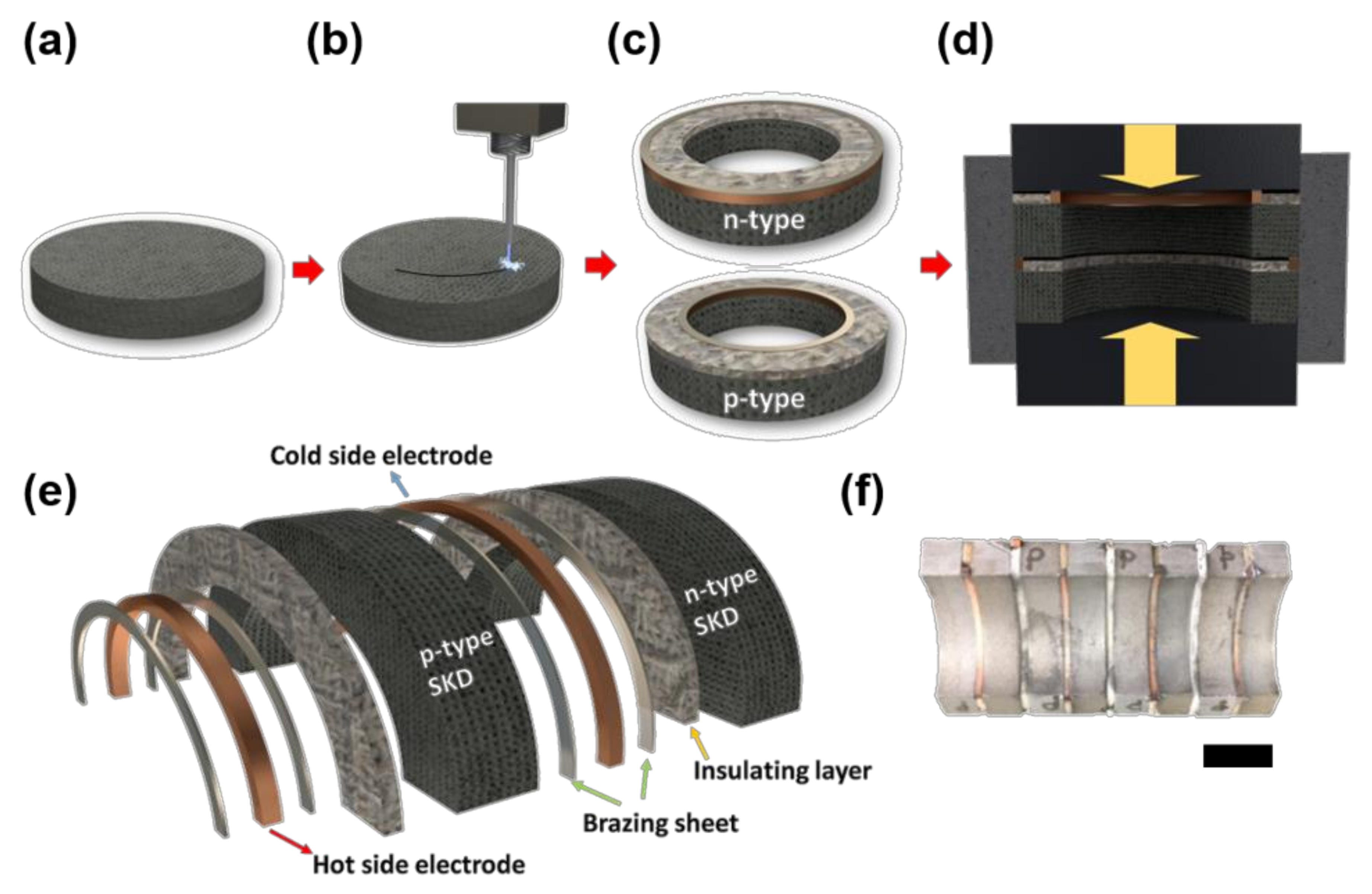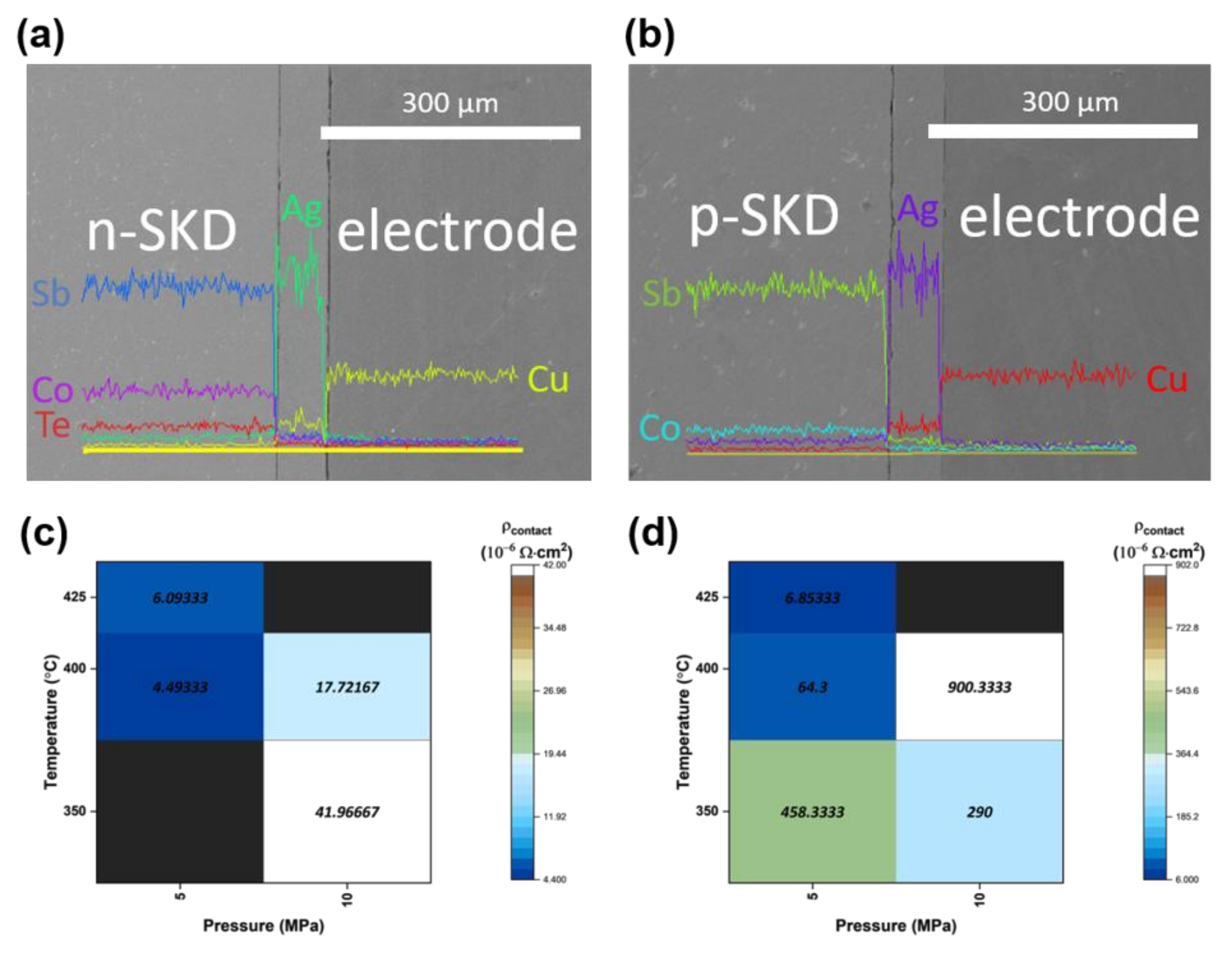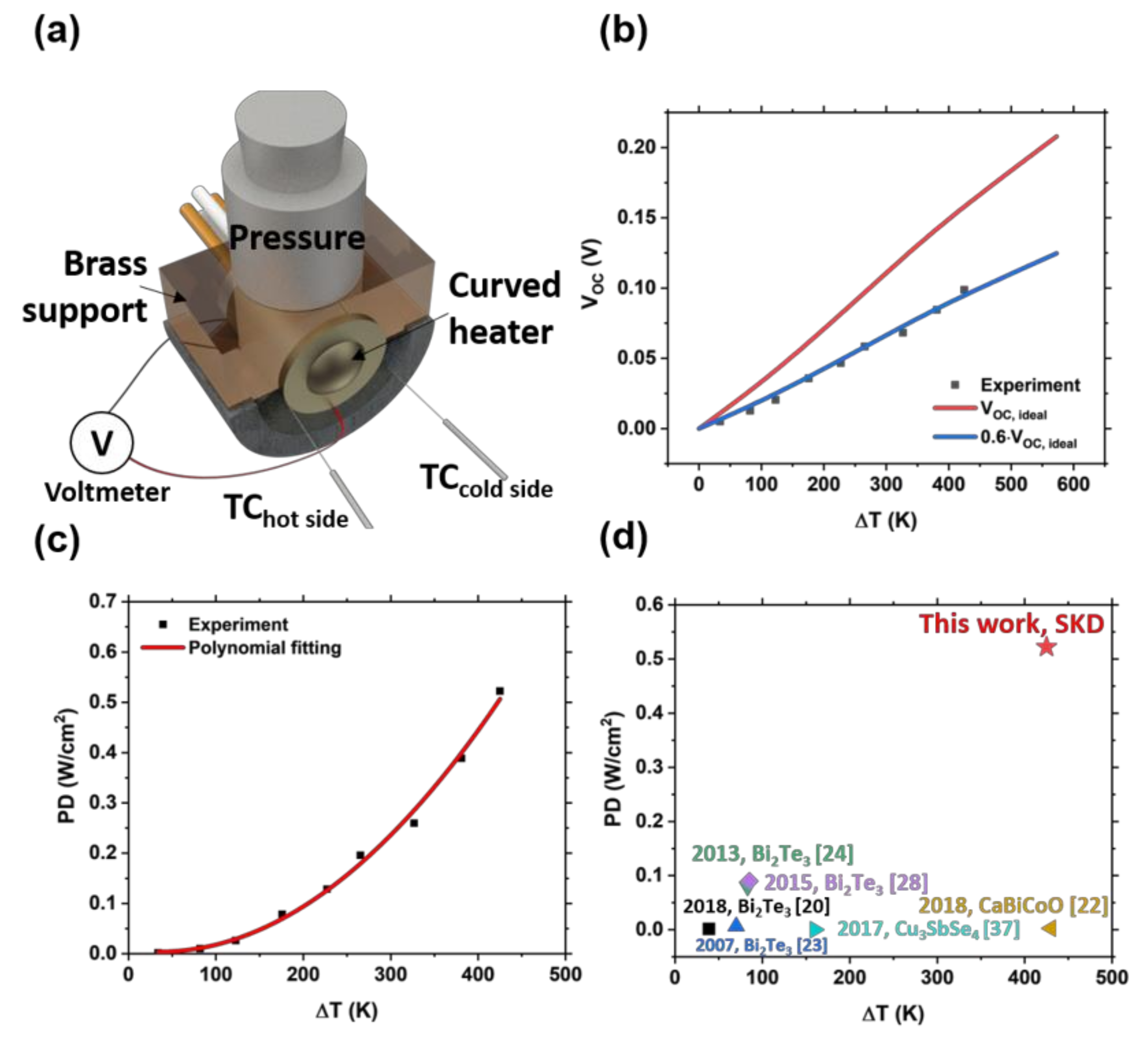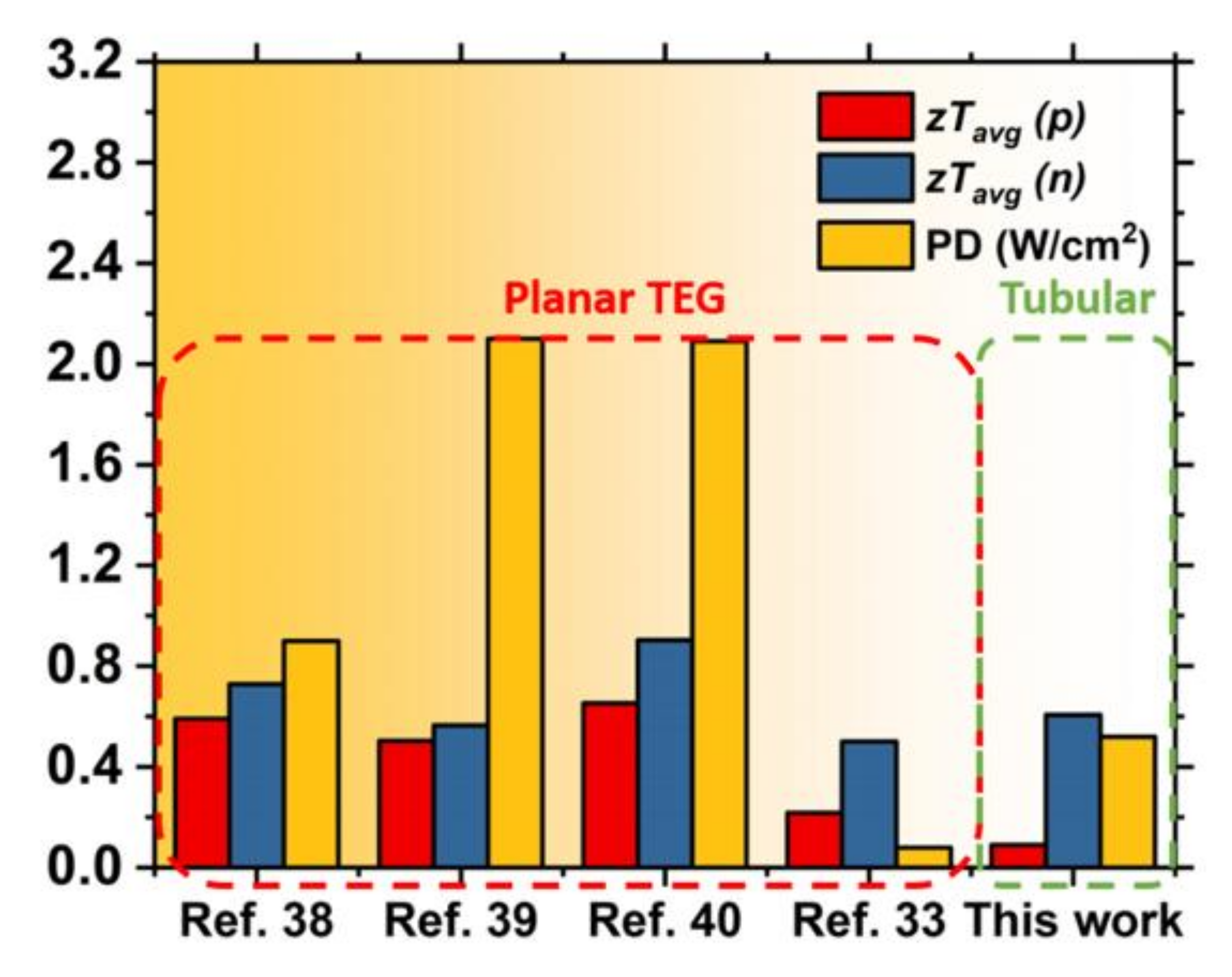Fabrication of Skutterudite-Based Tubular Thermoelectric Generator
Abstract
1. Introduction
2. Materials and Methods
2.1. Measurements of Thermoelectric Properties
2.2. Machining of the Components
2.3. Joining
2.4. Analysis on the Joining Interface
2.5. Module Performance Evaluation
3. Results and Discussion
3.1. Thermoelectric Properties of the Materials
3.2. Fabrication of the Tubular Module
3.3. Characterization of the Joining Interface
3.4. Measurement and Estimation of the Output Characteristic
4. Conclusions
Supplementary Materials
Author Contributions
Funding
Conflicts of Interest
References
- Snyder, G.J.; Toberer, E.S. Complex thermoelectric materials. Nat. Mater. 2008, 7, 105–114. [Google Scholar] [CrossRef] [PubMed]
- DiSalvo, F.J. Thermoelectric cooling and power generation. Science 1999, 285, 703–706. [Google Scholar] [CrossRef] [PubMed]
- Tritt, T.M.; Subramanian, M.A. Thermoelectric Materials, Phenomena, and Applications: A Bird’s Eye View. MRS Bull. 2006, 31, 188–198. [Google Scholar] [CrossRef]
- Leoni, A.; Pantoli, L. SPICE Model Identification Technique of a Cheap Thermoelectric Cell Applied to DC/DC Design with MPPT Algorithm for Low-Cost, Low-Power Energy Harvesting. Appl. Sci. 2019, 9, 3744. [Google Scholar] [CrossRef]
- Stomelli, V.; Leoni, A.; Ferri, G.; Errico, V.; Ricci, M.; Pallotti, A.; Saggio, G. A Multi-Source Energy Harvesting Sensory Glove Electronic Architecture. In Proceedings of the 2018 3rd International Conference on Smart and Sustainable Technologies (SpliTech), Split, Croatia, 26–29 June 2018. [Google Scholar]
- Leoni, A.; Ulisse, I.; Pantoli, L.; Errico, V.; Ricci, M.; Orengo, G.; Saggio, G. Energy harvesting optimization for built-in power replacement of electronic multisensory architecture. AEU Int. J. Electron. Commun. 2019, 107, 170–176. [Google Scholar] [CrossRef]
- Park, K.T.; Shin, S.M.; Tazebay, A.S.; Um, H.D.; Jung, J.Y.; Jee, S.W. Lossless hybridization between photovoltaic and thermoelectric devices. Sci. Rep. 2013, 3, 2123. [Google Scholar] [CrossRef]
- Kil, T.H.; Kim, S.; Jeong, D.H.; Geum, D.M.; Lee, S.; Jung, S.J. A highly-efficient, concentrating-photovoltaic/thermoelectric hybrid generator. Nano Energy 2017, 37, 242. [Google Scholar] [CrossRef]
- Wei, T.; Huang, Y.H.; Zhang, Q.; Yuan, L.X.; Yang, J.Y.; Sun, Y.M. Thermoelectric Solid-Oxide Fuel Cells with Extra Power Conversion from Waste Heat. Chem. Mater. 2012, 24, 1401–1403. [Google Scholar] [CrossRef]
- Chen, X.; Pan, Y.; Chen, J. Performance and Evaluation of a Fuel Cell-Thermoelectric Generator Hybrid System. Fuel Cells 2010, 10, 1164–1170. [Google Scholar] [CrossRef]
- Liu, X.; Deng, Y.D.; Li, Z.; Su, C.Q. Performance analysis of a waste heat recovery thermoelectric generation system for automotive application. Energy Convers. Manag. 2015, 90, 121–127. [Google Scholar] [CrossRef]
- Temizer, I.; Ilkilic, C. The performance and analysis of the thermoelectric generator system used in diesel engines. Renew. Sustain. Energy Rev. 2016, 63, 141–151. [Google Scholar] [CrossRef]
- Kim, S.I.; Lee, K.H.; Mun, H.A.; Kim, H.S.; Hwang, S.W.; Roh, J.W. Thermoelectrics. Dense dislocation arrays embedded in grain boundaries for high-performance bulk thermoelectrics. Science 2015, 348, 109–114. [Google Scholar] [CrossRef] [PubMed]
- Goto, Y.; Nishida, A.; Nishiate, H.; Murata, M.; Lee, C.H.; Miura, A. Effect of Te substitution on crystal structure and transport properties of AgBiSe2 thermoelectric material. Dalton Trans. 2018, 47, 2575–2580. [Google Scholar] [CrossRef] [PubMed]
- Sadia, Y.; Ben-Ayoun, D.; Gelbstein, Y. Evaporation-condensation effects on the thermoelectric performance of PbTe-based couples. PhysChemChemPhys 2017, 19, 19326–19333. [Google Scholar] [CrossRef]
- Zhang, Q.; Zhou, Z.; Dylla, M.; Agne, M.T.; Pei, Y.; Wang, L. Realizing high-performance thermoelectric power generation through grain boundary engineering of skutterudite-based nanocomposites. Nano Energy 2017, 41, 501–510. [Google Scholar] [CrossRef]
- Ngan, P.H.; Han, L.; Christensen, D.V. Joining of Half-Heusler and Bismuth Tellurides for Segmented Thermoelectric Generators. J. Electron. Mater. 2018, 47, 701–710. [Google Scholar] [CrossRef]
- You, L.; Liu, Y.; Li, X.; Nan, P.; Ge, B.; Jiang, Y.; Snyder, G.J. Boosting the thermoelectric performance of PbSe through dynamic doping and hierarchical phonon scattering. Energy Environ. Sci. 2018, 11, 1848–1858. [Google Scholar] [CrossRef]
- Varghese, T.; Hollar, C.; Richardson, J.; Kempf, N.; Han, C.; Gamarachchi, P. High-performance and flexible thermoelectric films by screen printing solution-processed nanoplate crystals. Sci. Rep. 2016, 6, 33135. [Google Scholar] [CrossRef]
- Kim, F.; Kwon, B.; Eom, Y.; Lee, J.E.; Park, S.; Jo, S.; Min, T.S. 3D printing of shape-conformable thermoelectric materials using all-inorganic Bi2Te3-based inks. Nat. Energy 2018, 3, 301–309. [Google Scholar] [CrossRef]
- Menon, A.K.; Meek, O.; Eng, A.J.; Yee, S.K. Radial thermoelectric generator fabricated from n- and p-type conducting polymers. J. Appl. Polym. Sci. 2017, 134. [Google Scholar] [CrossRef]
- Merkulov, O.V.; Politov, B.V.; Chesnokov, K.Y.; Markov, A.A.; Leonidov, I.A.; Patrakeev, M.V. Fabrication and Testing of a Tubular Thermoelectric Module Based on Oxide Elements. J. Electron. Mater. 2018, 47, 2808–2816. [Google Scholar] [CrossRef]
- Min, G.; Rowe, D.M. Ring-structured thermoelectric module. Semicond. Sci. Technol. 2007, 22, 880–883. [Google Scholar] [CrossRef]
- Sakai, A.; Kanno, T.; Takahashi, K.; Tamaki, H.; Adachi, H.; Yamada, Y. Enhancement in Performance of the Tubular Thermoelectric Generator (TTEG). J. Electron. Mater. 2013, 42, 1612–1616. [Google Scholar] [CrossRef]
- Wang, X.; Li, B.; Yan, Y.; Liu, S.; Li, J. A study on heat transfer enhancement in the radial direction of gas flow for thermoelectric power generation. Appl. Therm. Eng. 2016, 102, 176–183. [Google Scholar] [CrossRef]
- Boriboonsomsin, K.; Durbin, T.; Scora, G.; Johnson, K.; Sandez, D.; Vu, A.; Dai, Z. Real-world exhaust temperature profiles of on-road heavy-duty diesel vehicles equipped with selective catalytic reduction. Sci. Total Environ. 2018, 634, 909–921. [Google Scholar] [CrossRef]
- Schmitz, A.; Stiewe, C.; Muller, E. Preparation of Ring-Shaped Thermoelectric Legs from PbTe Powders for Tubular Thermoelectric Modules. J. Electron. Mater. 2013, 42, 1702–1706. [Google Scholar] [CrossRef]
- Sakai, A.; Kanno, T.; Takahashi, K.; Tamaki, H.; Yamada, Y. Power Generation and Peltier Refrigeration by a Tubular pi-Type Thermoelectric Module. J. Electron. Mater. 2015, 44, 4510–4515. [Google Scholar] [CrossRef]
- Khovaylo, V.V.; Korolkov, T.A.; Voronin, A.I.; Gorshenkov, M.V.; Burkov, A.T. Rapid preparation of InxCo4Sb12 with a record-breaking ZT = 1.5: The role of the In overfilling fraction limit and Sb overstoichiometry. J. Mater. Chem. A 2017, 5, 3541–3546. [Google Scholar] [CrossRef]
- Tang, Y.; Gibbs, Z.M.; Agapito, L.A.; Li, G.; Kim, H.S.; Nardelli, M.B.; Snyder, G.J. Convergence of multi-valley bands as the electronic origin of high thermoelectric performance in CoSb3 skutterudites. Nat. Mater. 2015, 14, 1223. [Google Scholar] [CrossRef]
- Liu, W.S.; Zhang, B.P.; Li, J.F.; Zhang, H.L.; Zhao, L.D. Enhanced thermoelectric properties in CoSb3-xTex alloys prepared by mechanical alloying and spark plasma sintering. J. Appl. Phys. 2007, 102, 103717. [Google Scholar] [CrossRef]
- Chiu, W.T.; Chen, C.L.; Chen, Y.Y. A strategy to optimize the thermoelectric performance in a spark plasma sintering process. Sci. Rep. 2016, 6, 23143. [Google Scholar] [CrossRef] [PubMed]
- García-Cañadas, J.; Powell, A.V.; Kaltzoglou, A.; Vaqueiro, P.; Min, G. Fabrication and Evaluation of a Skutterudite-Based Thermoelectric Module for High-Temperature Applications. J. Electron. Mater. 2012, 42, 1369–1374. [Google Scholar] [CrossRef]
- Zhang, Q.H.; Huang, X.Y.; Bai, S.Q.; Shi, X.; Uher, C.; Chen, L.D. Thermoelectric Devices for Power Generation: Recent Progress and Future Challenges. Adv. Eng. Mater. 2016, 18, 194–213. [Google Scholar] [CrossRef]
- Oh, M.W.; Ahn, J.H.; Lee, J.K.; Kim, B.S.; Park, S.D.; Min, B.K.; Lee, H.W. Estimation of Power Generation from Thermoelectric Devices: Model Analysis and Performance Measurements. Electron. Mater. Lett. 2010, 6, 129–134. [Google Scholar] [CrossRef]
- Kim, H.S.; Liu, W.; Chen, G.; Chu, C.W.; Ren, Z. Relationship between thermoelectric figure of merit and energy conversion efficiency. Proc. Natl. Acad. Sci. USA 2015, 112, 8205. [Google Scholar] [CrossRef] [PubMed]
- Liu, Y.; García, G.; Ortega, S.; Cadavid, D.; Palacios, P.; Lu, J. Solution-based synthesis and processing of Sn- and Bi-doped Cu3SbSe4 nanocrystals, nanomaterials and ring-shaped thermoelectric generators. J. Mater. Chem. A 2017, 5, 2592–2602. [Google Scholar] [CrossRef]
- Prado-Gonjal, J.; Phillips, M.; Vaqueiro, P.; Min, G.; Powell, A.V. Skutterudite Thermoelectric Modules with High Volume-Power Density: Scalability and Reproducibility. ACS Appl. Energy Mater. 2018, 1, 6609–6618. [Google Scholar] [CrossRef]
- Park, S.H.; Jin, Y.; Cha, J.; Hong, K.; Kim, Y.; Yoon, H. High-Power-Density Skutterudite-Based Thermoelectric Modules with Ultralow Contact Resistivity Using Fe-Ni Metallization Layers. ACS Appl. Energy Mater. 2018, 1, 1603–1611. [Google Scholar] [CrossRef]
- Li, W.; Stokes, D.; Poudel, B.; Saparamadu, U.; Nozariasbmarz, A.; Kang, H.B.; Priya, S. High-Efficiency Skutterudite Modules at a Low Temperature Gradient. Energies 2019, 12, 4292. [Google Scholar] [CrossRef]





© 2020 by the authors. Licensee MDPI, Basel, Switzerland. This article is an open access article distributed under the terms and conditions of the Creative Commons Attribution (CC BY) license (http://creativecommons.org/licenses/by/4.0/).
Share and Cite
Jang, H.; Kim, J.B.; Stanley, A.; Lee, S.; Kim, Y.; Park, S.H.; Oh, M.-W. Fabrication of Skutterudite-Based Tubular Thermoelectric Generator. Energies 2020, 13, 1106. https://doi.org/10.3390/en13051106
Jang H, Kim JB, Stanley A, Lee S, Kim Y, Park SH, Oh M-W. Fabrication of Skutterudite-Based Tubular Thermoelectric Generator. Energies. 2020; 13(5):1106. https://doi.org/10.3390/en13051106
Chicago/Turabian StyleJang, Hanhwi, Jong Bae Kim, Abbey Stanley, Suhyeon Lee, Yeongseon Kim, Sang Hyun Park, and Min-Wook Oh. 2020. "Fabrication of Skutterudite-Based Tubular Thermoelectric Generator" Energies 13, no. 5: 1106. https://doi.org/10.3390/en13051106
APA StyleJang, H., Kim, J. B., Stanley, A., Lee, S., Kim, Y., Park, S. H., & Oh, M.-W. (2020). Fabrication of Skutterudite-Based Tubular Thermoelectric Generator. Energies, 13(5), 1106. https://doi.org/10.3390/en13051106





